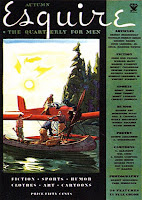
Sometimes you can't give your money away, at least not to magazines.
After picking up the February issue of Esquire because -- like everyone else who picked it up -- I liked the bold Obama cover, I saw the blow-in subscription card that featured an extremely inexpensive offer. One year (12 issues) of Esquire for six whole dollars. I figured if I buy just two issues of the magazine a year at the cover price of $3.99, the subscription would more than pay for itself. Then I noticed that I could get two years for $11 -- obviously, the math was even better. So I sent in the card, asking them to bill me.
All well and good. This week, then, I received my invoice. As I was preparing to fill out the form and include my check for a measely $11, I noticed a checkbox:
"Double My Savings! Send me an additional 24 issues for just $11.00 more."
Naturally, I figured the math was still on my side, so I was all set to take advantage of 48 issues of this odd little magazine when I saw another option on the invoice: For faster service, it promised, I could pay online, and it gave me the URL.
So I went. But after typing in my credit card info, the next screen did not give me an option to subscribe for 48 issues; I had to settle for just 24.
Now, I still got an incredible deal. I'm not complaining. I'll get each copy at just 45.83 cents. Think about that: The very first issue of the magazine, way back in 1933 (see photo), had a cover price of 50 cents, and that was before decades of inflation.
 And if I'd gotten four years on my subscription instead of two, the per-copy price would have been exactly the same as the 45.83 cents that I am getting.
And if I'd gotten four years on my subscription instead of two, the per-copy price would have been exactly the same as the 45.83 cents that I am getting.But I wouldn't have the out after two years, which I in fact exercised the last time I did a two-year stint as an Esquire subscriber. (I have a love-dislike relationship with the mag.) Even if I had renewed, the mag would still have to pay to send out renewal alerts and reminders.
So why offer one deal on the printed invoice, then not have that deal available on the online payment system to which the invoice directs me?















































